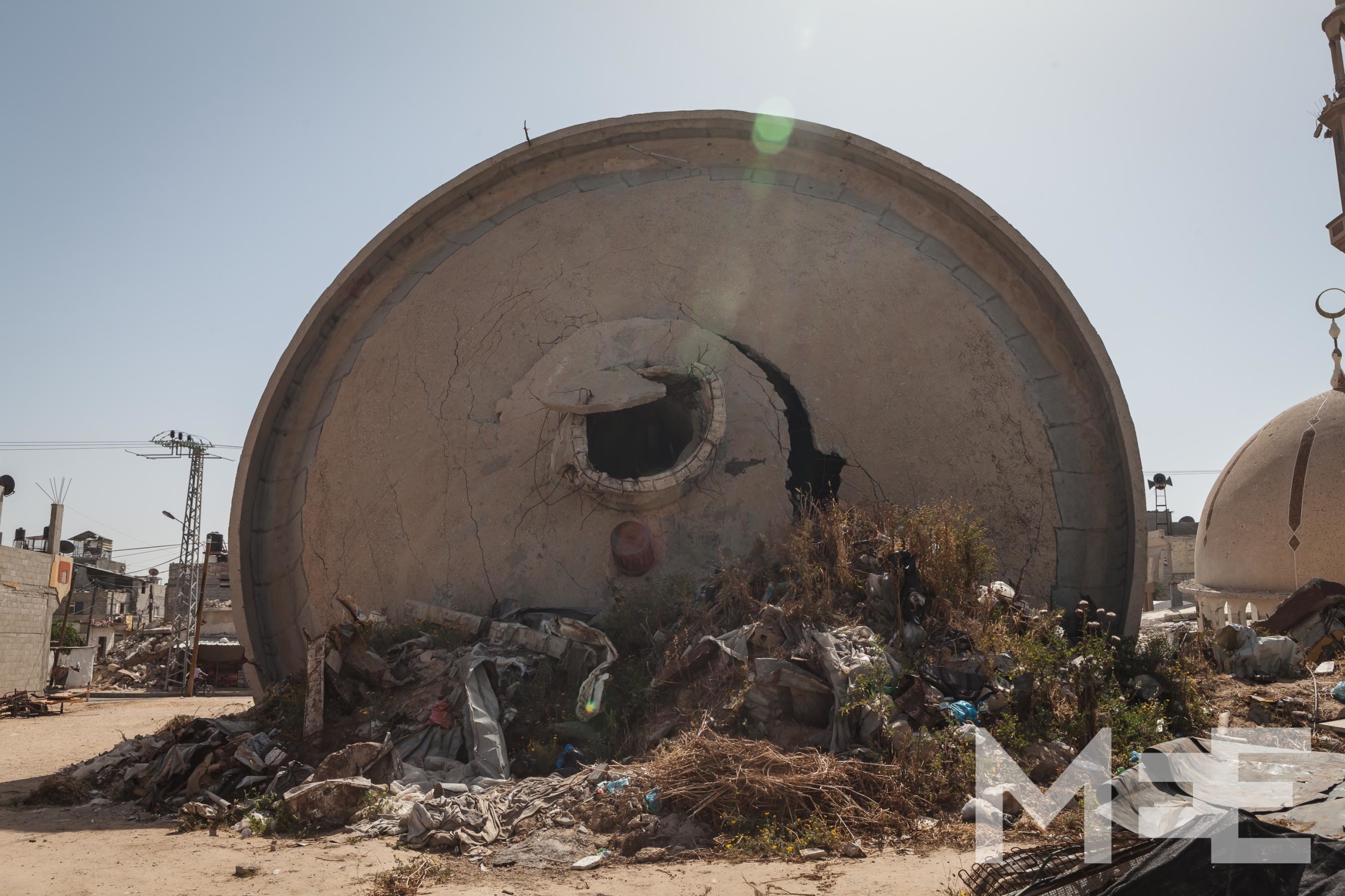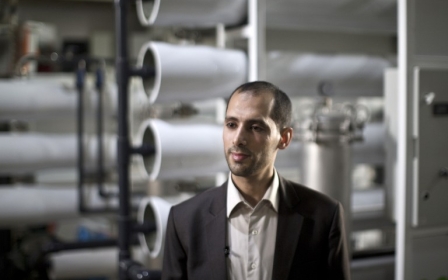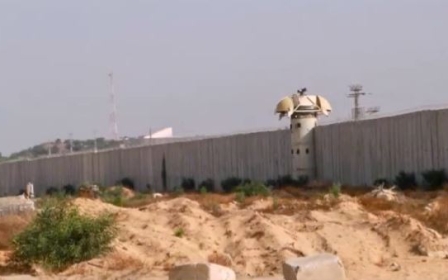Water in Gaza: A 'not-too-distant' calamity

GAZA CITY - The desert heat blankets the small town of Beit Hanoun, as the relative quiet of the small city in Gaza’s northeastern corner is interrupted by the distant chimes of “It’s a small world after all”. A truck glides through the narrow streets of the arid town, its speaker playing the jingle to the delight of the children and adults that run out to greet it. Aside from the dilapidated nature of some of the surrounding buildings, there is nothing altogether conspicuous about the scene, especially considering that it is so close to summer, save for the qualification that the truck is not there to sell ice cream- rather, it is there to deliver water.
Throughout the Gaza Strip, there has been a chronic shortage of clean water, complemented and enhanced by a corresponding energy crisis that existed long before the 51-day war with Israel that took place last July and August. The war and its aftermath, however, have since taken what was already a serious encroaching emergency and made matters far worse, with a possible tipping point towards a full-fledged calamity in the not-too-distant future.
Like most issues that plague the 360-square-km Strip wedged between Egypt and Israel, the issue of water is highly complex and difficult to separate from an array of other problems. However, the issue of water in Gaza is essential toward an understanding of the underlying structural deficits that play a significant role in the conflict.
James W. Rawley, United Nations Deputy Co-Coordinator for the Middle East Peace Process (UNSCO), put it this way, “We need international support to reconstruct Gaza, to repair the damages (inflicted) over the summer, but we also need international support to address the underlying development issues, and in a nutshell they relate to two things: water and energy.”
Indeed these are two of the most pressing issues affecting the people of Gaza in their daily lives. While considerable international commitments have been made for Gaza’s reconstruction, notably at the Cairo Conference last October, which pledged $4 bn to repair housing, considerably less is being done about Gaza’s structural deficit.
The water crisis is defined and exacerbated by three factors: lack of infrastructural capacity, increased demand and overuse of existing infrastructure, and an energy shortage. Each issue overlaps into the other, and are further synthesised by the water system itself having been pulverised during the conflict last summer. The result is that today in Gaza, between 95-97 percent of Gaza’s water is undrinkable, and according to UN estimates, Gaza itself will be unlivable by the year 2020 unless immediate action is taken to reverse current trends.
The Gaza Strip gets all of its water from only one source: The Gaza Coastal Aquifer, an underground, natural geological formation located along the Mediterranean coast. Over the past several decades, the population of Gaza has grown exponentially, with around 51 percent of Gazans under the age of 15. The increased demand for housing, coupled with a lack of building materials due to the Israeli blockade, has led to denser concentrations of people in a limited number of population centres. Subsequently, the aquifer is being overused, and may be functionless at some point in the next two years.
The overuse of the aquifer results in a further and potentially more disastrous caveat - the aquifer itself is sinking.
Previously, water ran from the east into the sea, carrying with it waste from major population centres as far away as the Jordan Valley. According to the Coastal Municipalities Water Utility (CMWU), the aquifer has sunk a full 40 metres in the past few decades due to overconsumption, with the extraction rate at three times higher the rate of aquifer recharge. Since the level of the aquifer has decreased, the aquifer is being dumped with both salt water from the sea from the west, and any runoff from local septic tanks or fertiliser from farmlands (chemical and organic) coming from the east. The salt water content renders most of Gaza’s water too salty for drinking and agricultural use. The salt water also rapidly deteriorates Gaza’s pumping lines, and hence hampers the government’s ability to even disseminate the water.
The pollution has resulted in astronomically high levels of chloride iron, with well samples yielding as much as 3,000 milligrams per litre (mg/l), far above the World Health Organisation’s (WHO) limit of 250 mg/l. Samples taken from 230 of Gaza’s wells have shown similarly alarming rates of nitrogen, as high as 3-400 mg/l, compared to the WHO limit of 70 mg/l.
Despite the high health risks and danger of permanently damaging Gaza’s only water resource, officials say they have no option but to use the aquifer’s water.
“The problem is with the quality and quantity" of water, says a chemist with the CMWU Khan Younis Regional Office. "Every person needs 70-90 litres of water per day, and you need at least 150 liters to cover this.” There is simply no other place that can fulfil that kind of demand.
“When the water is salty, it damages the main appliances of the house, the washer, the faucets, everything in the house. You also can’t shower with it or irrigate with it. So it’s a cycle. You cannot use the salt water because you will damage the household appliances,” Mahan Rashar, deputy general director of the CMWU, told Middle East Eye. “People cannot bear to drink this water, but if they use it for other activities it damages things. This is a disaster. Ninty-five percent of the water is polluted … it’s like extracting from a dead body.”
Families try to compensate by purchasing water from private companies, delivered by trucks. The private water is expensive and produced by converting brackish water (water with slightly less salinity than seawater) through small-scale, unregulated desalination plants throughout the Strip. According to a recent UN report, the soundness of potable water produced in this manner is questionable.
Since the end of the war, local municipalities have taken to delivering water in vans and tankers, over-pumping from wells that went undamaged during the conflict.
MEE spoke with Ramsey Ahmed, assistant to the director general of Gaza City Municipality, whilst he was on sight overseeing the reconstruction of the al-Mutar. “We try to overpump and build new wells. But we don’t have enough materials to, and there is a problem with electricity. We have no storage power. So it’s a problem of continuously being able to work and continuously being able to supply the water.”
The water system is further overwhelmed by the digging of illegal wells closer to operational ones by poor farmers.
Mohammed, 40, is a fruit and vegetable farmer in the northern city of Beit Lahiya. For a Gaza farmer, he does remarkably well, producing a diversified crop on a fairly large swath of land. Yet it is both telling and foreboding for Gaza’s future that even a relatively well-off farmer may not be able to maintain his enterprise far into the future, due to the cost of importing water and power shortages. He is increasingly worried about his ability to preserve his produce, as despite receiving instructions on preservation techniques by international NGO’s he lacks the power and the building materials to do so. “We have bad days coming ahead I think,” Mohammed told MEE.
While it has been a year of high rainfall for the region, the need for a stable, clean source of water will only increase as the water networks and supply are strained in the encroaching summer months.
Israel has provided some relief in the form of pumping an extra five million litres of water into Gaza, a commitment that it has recently doubled to ten million. The question of how to pump this water to residents has, however, been compounded by damage to the water system (estimated at $33.38 million) done during the July-August War last year. The al-Mutar reservoir, where Israel pumps its additional water, was damaged during the war as well, and therefore the Palestinian Water Authority (PWA) cannot yet pump the water to the residents. This includes 26 wells that were damaged or completely destroyed, along with two treatment plants and six distribution centres. According to a CMWU report, several areas around the Gaza Strip may need a complete redesign of their water networks, based on an influx of refugees that moved to those areas during the war, and are unable to move back due to the loss of their homes during the conflict.
Such is the case in the refugee camps located in the eastern part of Khan Younis, where residents live in makeshift and clustered housing.
Hatem Taha Abu Eltayef, Khan Younis CMWU's regional office manager, spoke to MEE on the difficulties encountered in providing water to the refugees: “Khan Younis has about 230,000 inhabitants which occupy about 5,700 kilometres. During the last war in Gaza, there was damage to people in the eastern part of Khan Yunis to about 100,000 inhabitants, 80 percent of (whom) moved to Khan Younis during the war so because of the war, the aggression, et cetera … But these areas were not prepared to have people settle in them. You need to make toilets, you need to make showers, you need to provide them with water and food, and this was a big headache for the municipality and the other stakeholders on this site.”
A strategy to deal with Gaza’s water crisis has been in place for some time. The foremost priority is the building of a permanent desalinisation plant in Gaza. Plans were underway to build one as far back as 2004, but it has yet to be built. Today, the preferred site of the plant is used as a lagoon to clean sewage, which processes 15,000 cubic metres of sewage material, despite only being designed to process 13,000. Dilapidated materials mean that some pathogens make their way through the sand into the aquifer, and increasingly the Khan Younis Water Authority has had no choice but to pump the excess sewage into the sea resulting in damage to the local marine life.
“I haven’t swum in the sea in nine years,” said Abu Eltayef.
“A big plant like that needs a steady political situation in Gaza,” said Mahan Rashar, the deputy general director of CMWU: “Aside from the willingness of the donors to pay for it, there’s also the energy crisis we have in Gaza … How can I operate a plant with no electricity and no people on the ground? ”
There are plans underway to build three smaller, temporary desalination plants at three separate locations throughout Gaza, the first of which is due to be completed next year. There are also plans to build a large water catch, which officials say would resolve both the problem of pollution run-off, and give the aquifer a much needed period of rest and replenishment. CMWU is currently working in partnership with organisations such as the World Bank, KFW, and the International Committee of the Red Cross (ICRC), among others for rebuilding and maintenance of the water network. Due to the Israeli blockade, however materials for reconstruction are very difficult to come by, and reconstruction is at a piecemeal pace.
“Business is very slow,” said Bahar, a site engineer during the reconstruction of a water well overlooking Gaza City. When asked about the lack of funding for long-term infrastructure projects, his assistant Mohammed, 24, shrugged and told MEE that he believed that in two years he’d be back there rebuilding the same well again.
New MEE newsletter: Jerusalem Dispatch
Sign up to get the latest insights and analysis on Israel-Palestine, alongside Turkey Unpacked and other MEE newsletters
Middle East Eye delivers independent and unrivalled coverage and analysis of the Middle East, North Africa and beyond. To learn more about republishing this content and the associated fees, please fill out this form. More about MEE can be found here.




